Last Thursday it was in the 20’s with snow and ice several days later it was in the 70’s. It reminds me of sugaring season. Sugaring season was a really fun time growing up. Sugaring season happens in late winter/early spring. The ideal weather for sugaring is several cold nights below freezing followed by rapidly warming, sunny days. The ideal temperature for sap flow is just at 40 degrees. The excess starches stored in the wood all winter turn to sugar(sucrose) when the temperature warms to about 40 and passes into the tree sap enabling the production of syrup. Once the temperature warms over 45 degrees the sugars are no longer produced.
Growing up in Vermont, Sugaring (making maple syrup) was a way of life for a lot of people. For my family it was just a really fun but labor intensive hobby. However, we were able to reap the benefits of a week or two of hard work all year long.
I don’t really remember when we decided we would make maple syrup I just remember doing it for a few years. My dad’s best friend was the father of my sister’s and my best friends. Their mother was my mom’s best friends. We did a lot of stuff together and one year my dad and Tony got the idea that we were all gonna make maple syrup. My dad and Tony built this amazing wood fired evaporator in our back yard. The evaporator is where all the magic happens! Later they moved the operation to Tony and Pam’s house but for at least a year it was in our back yard.
Tapping the Trees
Making syrup begins with tapping the trees. For the best results only sugar maples should be used. The sap created by other maple trees has a much lower sucrose ratio causing a more bitter syrup. Trees should measure a minimum of 10 inches in diameter before tapping. For every 8 additional inches in diameter an additional tap may be added to the tree. Three basic supplies are needed to tap a tree.
A drill.
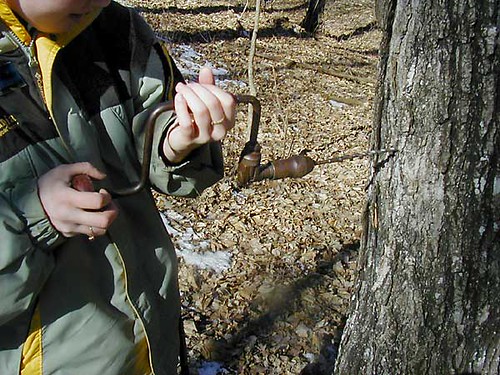 (photo found on Google.com)
(photo found on Google.com)
A tap.
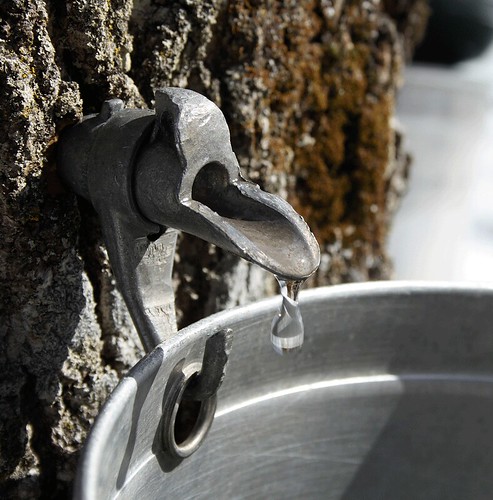 (photo found on Google.com)
(photo found on Google.com)
And a bucket.
 (photo found on Google.com)
(photo found on Google.com)
The drill is used to bore a 1 1/2 inch hole into the tree about 3 feet above the ground. A tree tap is inserted into the hole and a bucket is then hung from the tap. Most taps are equipped with a little hook which holds the bucket. The sap flow can vary from a light drip to a steady stream. Nothing beats the sound of the sap pinging into a freshly emptied metal bucket. Ping. Ping. Ping.
 (photo courtesy of my mom)
(photo courtesy of my mom)
The photos above show our collection operation from 1992. We had graduated to larger 5 gallon collection tanks and plastic tubing. The process was the same but we had taps from several trees feeding into a larger collection tank instead of many buckets on many trees. You can see the 5 gallon buckets and tubing if you look closely at the picture on the top right.
Collecting The Sap
Once trees are tapped the sap must be collected often during the sugaring season which can last from a day or two to about two weeks. If we are really lucky we may even get two sugaring seasons in one year! Sap is sort of like milk. It can and will spoil! The sap must be collected often and immediately processed or placed into cold storage until it can be used.
We had large 20 gallon drums that we placed in the back of our Jeep. We would drive around our property and lug the smaller containers to the drums and pour them in. The smaller containers would immediately be set back out to the trees to collect more sap. This was a daily process. Each morning and sometimes in the evening as well we would ride around collecting the sap. Keep in mind it takes almost 10 gallons of sap to make just 1 quart of finished syrup!!!!
Boiling the Sap
The term used for the contraption used to boil the sap is called the evaporator. Essentially when making syrup, you are boiling off the waters leaving behind the sugars. Evaporators can be anything from a large pot, kettles over an open fire or a contraption like my dad and Tony built.
Here is my dad at the evaporator.
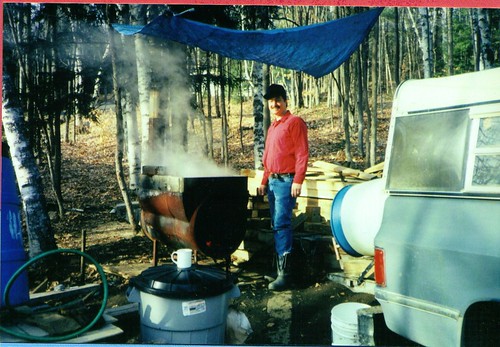 (photo courtesy of my mom)
(photo courtesy of my mom)
Our evaporator was wood burning. The sap must be heated to 7 degrees above the boiling point of water for it to become syrup. This process takes a REALLY long time. Any sap made below this temperature can spoil easily and sap heated above this temperature can form granules (maple sugar) in it.
Here are Tony and Russ.
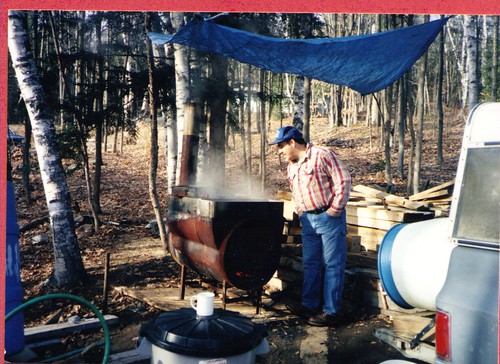
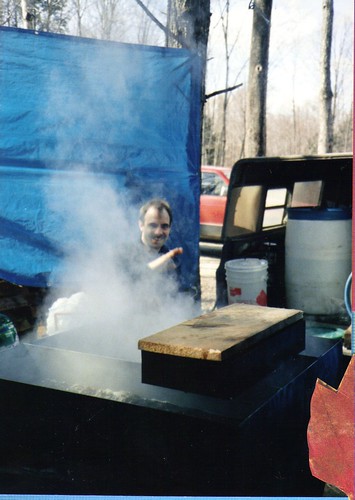
Here is a picture of my sisters best friend Kimmie (left) and ME (right)! Yup that’s me in 1992!!

Canning the Syrup
Once the syrup is boiled to the proper temperature it is time to filter it and can it. Many stores in Vermont sell empty syrup jars with lids kind of like what you would find for gardening in the summer. Syrup should be canned while at at least 180 degrees for a good seal. Syrup can last indefinitely. It is recommended that it be stored in a cool place and ideally in the freezer. (Maple Syrup will NOT freeze!) If you have proper seals on your jars they can store well on a pantry shelf but should at least be refrigerated once opened.
Maple syrup can also be used to make candy, sugar and creams. Here is a helpful link. http://www.massmaple.org/candy.html
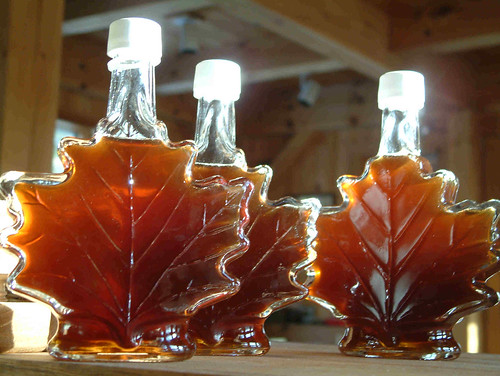

Julie,
Thanks for posting this. I really enjoyed reading it, and now I want to make my own maple syrup! Someday it will happen…
– Elizabeth Ann